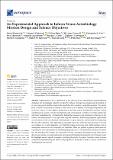An Experimental Approach to Inform Venus Astrobiology Mission Design and Science Objectives
Author(s)
Duzdevich, Daniel; Petkowski, Janusz J.; Bains, William; Cleaves, H. James; Carr, Christopher E.; Borowska, Ewa I.; Azua-Bustos, Armando; Cable, Morgan L.; Dorrington, Graham E.; Grinspoon, David H.; Ligterink, Niels F. W.; Riedo, Andreas; Wurz, Peter; Seager, Sara; ... Show more Show less
Downloadaerospace-09-00597.pdf (274.8Kb)
Publisher with Creative Commons License
Publisher with Creative Commons License
Creative Commons Attribution
Terms of use
Metadata
Show full item recordAbstract
Exploring how life is distributed in the universe is an extraordinary interdisciplinary challenge, but increasingly subject to testable hypotheses. Biology has emerged and flourished on at least one planet, and that renders the search for life elsewhere a scientific question. We cannot hope to travel to exoplanets in pursuit of other life even if we identify convincing biosignatures, but we do have direct access to planets and moons in our solar system. It is therefore a matter of deep astrobiological interest to study their histories and environments, whether or not they harbor life, and better understand the constraints that delimit the emergence and persistence of biology in any context. In this perspective, we argue that targeted chemistry- and biology-inspired experiments are informative to the development of instruments for space missions, and essential for interpreting the data they generate. This approach is especially useful for studying Venus because if it were an exoplanet we would categorize it as Earth-like based on its mass and orbital distance, but its atmosphere and surface are decidedly not Earth-like. Here, we present a general justification for exploring the solar system from an astrobiological perspective, even destinations that may not harbor life. We introduce the extreme environments of Venus, and argue that rigorous and observation-driven experiments can guide instrument development for imminent missions to the Venusian clouds. We highlight several specific examples, including the study of organic chemistry under extreme conditions, and harnessing the fluorescent properties of molecules to make a variety of otherwise challenging measurements.
Date issued
2022-10-13Department
Massachusetts Institute of Technology. Department of Earth, Atmospheric, and Planetary Sciences; Massachusetts Institute of Technology. Department of Physics; Massachusetts Institute of Technology. Department of Aeronautics and AstronauticsPublisher
Multidisciplinary Digital Publishing Institute
Citation
Aerospace 9 (10): 597 (2022)
Version: Final published version